Daily Classic: 7 Reasons Super Metroid was an SNES Masterpiece
Happy 25th birthday, Super NES! Look back at the fundamental brilliance of one of the console's all-time greatest creations with this piece from the USgamer archives.
This article first appeared on USgamer, a partner publication of VG247. Some content, such as this article, has been migrated to VG247 for posterity after USgamer's closure - but it has not been edited or further vetted by the VG247 team.
Originally published Feb. 2014
20 years ago, Nintendo published a master class in game design, a work some call the greatest game of all time: Super Metroid. This third chapter of the Metroid saga refined the concepts explored so imperfectly Metroid and Metroid II while standing as a great in its own right.
Little wonder that so many indie titles openly imitate Super Metroid. There's hardly a single false note in Nintendo's Super NES action adventure, and its structure and content are utterly addictive. I've certainly devoted tens of thousands of words to singing praises of the game over the years -- perhaps more than for any other game I've ever played. It's the kind of game you can return to time and again and always come away with some fresh insight or observation. Rather than simply write yet another gushing review of the game to mark its 20th anniversary, instead I'd like to talk about seven features that I feel were the key to its artistic success.
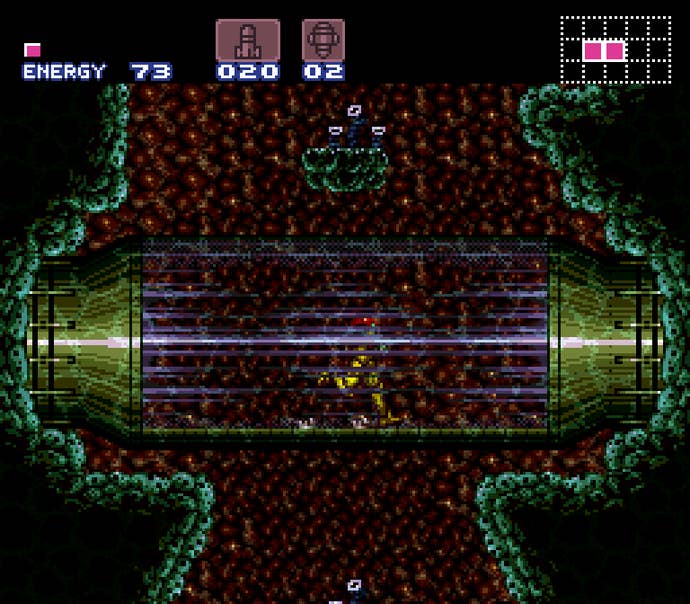
1. Boundary-pushing visuals and music, but not at the expense of game design
Strange to think, in an age in which Nintendo has long since shied away from pushing technical boundaries, but when it first arrived Super Metroid was the largest game ever released (in terms of storage capacity) on Super NES. At 24Mb, it eclipsed everything that had come before it, both first- and third-party. And its designers made deft use of that space. The subterranean passages of Zebes were absolutely immense, yet unlike the repetitive corridors of the original Metroid they came packed with variety. Each room had its own look, and often employed a unique gimmick -- whether that be a specific means of traversal, an unexpected trap, a new kind of enemy, or simply a devious puzzle hiding away a collectible item.
Super Metroid's creators crammed the game with all sorts of detail. From Samus' subtle idle animation and non-mirrored sprite (her main weapon is mounted to her right arm, and don't you forget it) to the countless secret mechanics and Easter eggs, every byte of data invested in Super Metroid served to make its world more immersive, its action more dynamic, and its mazes more devious.

2. Perfect integration of weapons and tools
The most fundamental rule for Metroid's weapons: They aren't simply about blowing up monsters. Every weapon Samus Aran collects in the course of her adventures serves a greater purpose beyond merely making things explode. Even if they simply serve double duty as a key -- as with missiles opening red doors -- everything in Samus' arsenal has value beyond basic combat. Not coincidentally, Super Metroid doesn't feature an inventory to speak of; while you can duck into a subscreen to activate or deactivate Samus' powers, you never have to worry about finding a key card or some obscure widget to help you explore the labyrinthine depths of Zebes. Her power-ups take care of that for her.
The one except to this rule is the X-Ray Scope, which serves a single purpose (revealing hidden passages) and has no combat value. Fittingly, it's a totally optional upgrade, tucked away in a fairly out-of-the-way area. Otherwise, though, Samus is a remarkably efficient explorer, carrying only what she needs.
As a corollary to this fact, almost every weapon has even more esoteric features beyond their obvious uses. The Super Missile, for example, causes a small tremor that can dislodge enemies from walls and ceilings. The Grappling Beam may not seem like much of a weapon, but it's remarkably effective against certain "invincible" enemies that shrug off all other forms of attack... and on top of that, it can be used to "cheat" in a difficult boss battle for a quick and dirty win. The Power Bomb opens certain doors and wipes the screen clean of enemies, but it's also valuable for quickly exposing destructible blocks. There are even techniques so advanced that friendly little creatures in the depths of the caves demonstrate them for Samus. Or, in the case of the ultimate Crystal Flash technique, so advanced that even the attract mode demonstration will still leave you guessing how it actually works. Despite having completing the game dozens of times over the years, I still find myself discovering new techniques and applications every time I revisit Super Metroid.
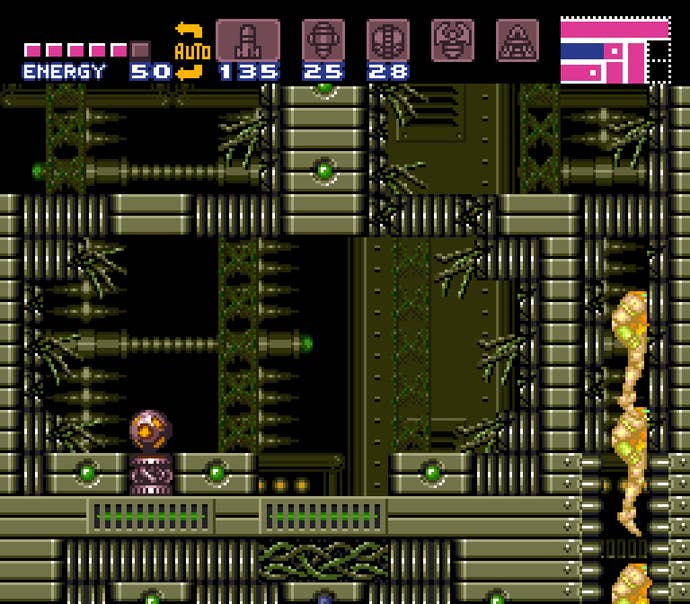
3. Incredible level design
Much of the efficacy of Super Metroid's weapon-tools comes from the fact that the world around Samus is so exquisitely crafted. Maybe it's not entirely realistic that the evil Space Pirates would construct a base around an ancient civilization in just such a way that all the items Samus would find within would allow her to reach their command center in an orderly fashion while collecting 100% of the weapons laying around. But who cares? Logic and great game design don't always intersect -- and that's OK, because logic is a commodity. Great game design, that's harder to come by.
The corridors of Zebes constantly guide players toward their goals in a subtle fashion, without ever being too conspicuous about it. It's perhaps the greatest-ever example of linear design disguised to feel open-ended. Super Metroid always gives you the freedom to sort things out on your own while at the same time quietly closing doors behind you or dropping you down a hole too deep for you to climb out of until you acquire your next essential upgrade. It's very difficult to become completely lost in Zebes, because the game has a way of trapping you in the vicinity of where you need to be going.
It never really feels that way, though, because you always end up trapped in a large enough cage that you don't notice the bars. While you can often backtrack, the most crucial moments of progression gently nudge you toward essential solutions. You may feel lost from time to time, but never for long. The way forward is always nearby. You just need to figure out how to find it.
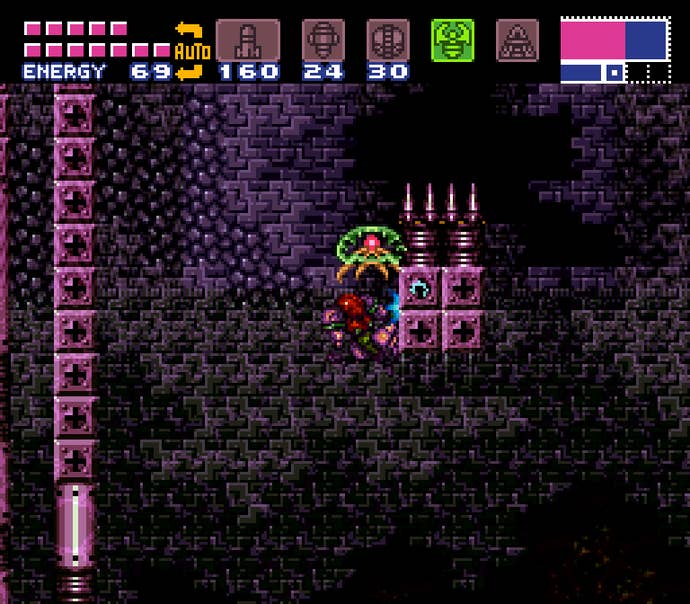
4. Substantial without overstaying its welcome
Super Metroid offered players a significant upgrade in terms of content and volume over its predecessors. Well, sort of; its labyrinth is only moderately larger than that of Metroid II, but because it's so much more intricate in its design and its secrets are so much more dense and interconnected, it feels far meatier. You'll retrace your steps through certain areas of Super Metroid several times, but you never feel like you're spinning your wheels; each time you revisit a region, you do so equipped with new tools -- that is, weapons -- that allow you to see that part of the world in a different light. When you finally find yourself empowered to connect with the tantalizing little items and passages you previously could see but couldn't reach, all you feel is immense satisfaction at finally satisfying a nagging sensation at the back of your mind. Super Metroid makes you itch, then slowly dispenses the balm to soothe that sensation.
Super Metroid doles out power-ups and other upgrades in a steady dopamine drip, perfectly timing Samus' major skill enhancements. Just as you've finally gotten a handle on one ability and start to feel that things are entering a steady groove, another power comes along and shakes things up anew. There's never a chance for boredom to set in, yet Samus' powers never come in such rapid succession that you ever feel overwhelmed or that a new technique is underutilized. And all along the way, minor enhancements (i.e., expansions for existing weapons and Energy Tanks) appear to keep you feeling like you're making progress and motivated to search. It's the same stick-and-carrot most RPGs employ, and despite Super Metroid's stripped-down mechanics versus a proper role-playing game, it's every bit as effective here as in something like Final Fantasy Tactics.
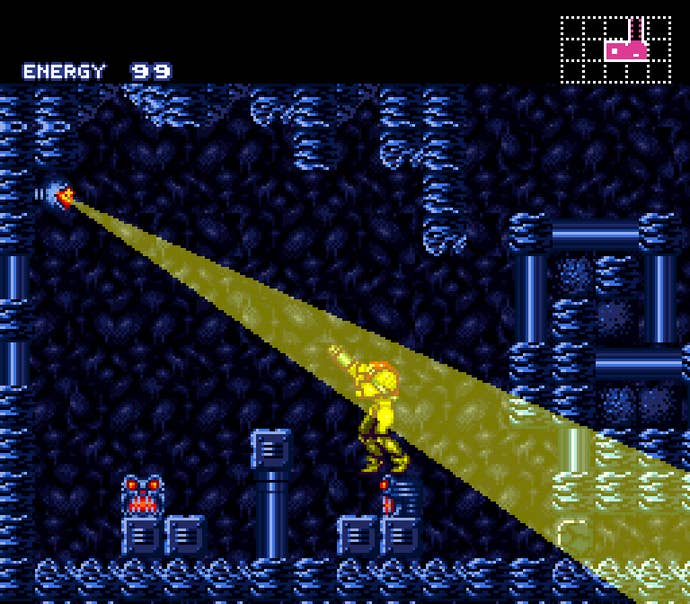
5. A minimal but affecting story
Super Metroid doesn't have much in the way of story, at least not in the usual sense of the word. Once you sit through the brief introductory narration -- the first time in the entire series Samus Aran is given voice -- the only words you'll see on-screen for the remainder of the adventure come in the form of tool tips to explain how to activate a new power. But the plot that unfolds throughout the course of the game does so wordlessly, without ever switching to a cut scene or throwing up a dialogue box.
Nevertheless, Super Metroid features one of the most memorable stories ever to appear in a video game. Much like Strider, Super Metroid conveys its underlying tale through the incidental details of its world, and through pantomime. There's a story behind the tunnels that crisscross subterranean Zebes: From the charred ruins of Mother Brain's former lair to the remains of an ancient crashed starship whose flickering monitors seemingly display a warning image of the deadly metroid parasites, every place you explore seems to have its own hidden meaning. The game never stops to explain itself, though; it leaves players to guess at what they've found. You can construct your own backstory for the planet if you like, draw your own conclusions about the nature of the Space Pirates and their mission. There is no "wrong" way to interpret Super Metroid's story, because it's all left deliberately vague. Who's the dead guy outside Kraid's lair? Is that a science lab cutting through the center of Maridia? What's with the turtle-like creature trying to protect its babies? Super Metroid has no explanations for you. You provide your own answers.
Compare that to Metroid Prime, which mimicked Super Metroid's structure and atmosphere to a fault but let you scan every item and room you encountered for more information. While the data you uncovered at your discretion did provide a logical sense of progression to the final boss, it still felt cumbersome compared to Super Metroid's elegant silence. From the ominous opening moments in which Samus returns to the seemingly dead world of Zebes only to realize she's being watched all the way to the intense finale, Super Metroid tells an intriguing story without a word -- and in its muteness, it sparks players' imagination in a way that simply explaining everything could never have done.
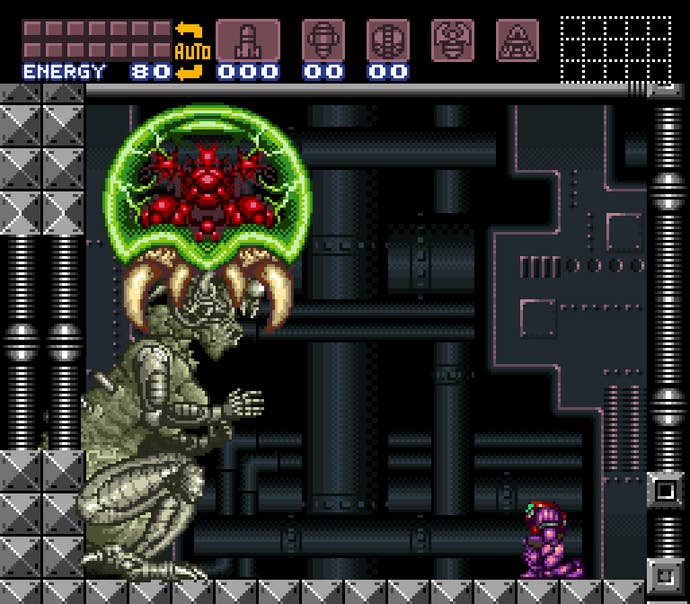
6. That amazing finale
Speaking of the finale, the real high point for Super Metroid's quiet narrative was by far its absolute least subtle moment. At the end of Samus' journey, she faces off against the Mother Brain once again, only to discover her nemesis has received a massive upgrade. The reprise of Metroid's final battle is but a warm-up for the real Mother Brain, now a massive biological computer capable of unleashing hellish beams of destructive energy. Samus, teetering at the brink of defeat, is saved by the last-minute self-sacrifice of the deadly "super metroid" -- the metroid larva that imprinted on her as its "mother" at the end of Metroid II. Empowered by the metroid's final gift, Samus makes short work of Mother Brain and flees the dying planet.
It's a powerful moment that works in large part because it represents the culmination of three games' story beats. The revelation of Mother Brain's true form is a shocking twist on the original game, while the baby metroid's sacrifice brings the second game's ending full circle. And only at the end do you realize that a seemingly trivial bit of information in Super Metroid's intro -- the capacity for metroids to create energy as well as consume it -- was setting up Samus' final weapon upgrade, the Hyper Beam that's bestowed by the metroid's death. As for the baby metroid's shocking mutation, that actually came from the narrative thread binding the entire game, from its abduction in the prologue to Samus' discovery of its shattered container upon defeating Ridley to the bizarre gallery of creatures turned to dust. The early Metroid games didn't do much overt storytelling, but what little existed comes into razor-sharp focus at the end.

7. It respected the player
The single most important thing Super Metroid did, however, was to respect the player. That may seem an obvious feature -- so essential a consideration as to not be a proper feature, in fact -- but respect for the player is something in short supply in video games. Super Metroid's trust in you permeates the game, manifesting in every possible facet of the adventure.
Super Metroid has no hand-holding; it guides players to play the proper way, but it never strongarms them. It gives adventurers the freedom to learn, but also the freedom to fail, to get lost. It reveals its working in subtle ways; for instance, players might never realize that the Super Missile can knock enemies loose from walls on their own, but you're forced to use them for the first time to open a door near where a couple of monsters are hidden along the ceiling. That explosion, required to progress further, dislodges them. If you don't grasp this secondary function of your new weapon, it's not the game's fault; it's because you didn't pay attention when it was giving you its discreet lesson.
Even when the game lays out its details plain to see, it places the burden of making sense of these facts on the player. When you uncover a new region's map via the map rooms, certain areas are left unrevealed, and the connections between different rooms remain opaque until you sort them out for yourself. What the map reveals do accomplish, however, is to give you a general sense of where you need to go and when it's time to backtrack or move along. The map data also has a tendency to include certain areas that can't immediately be accessed, leaving little unexplored spots to tug at your attention as you make you way through old haunts again.
Super Metroid doesn't waste your time, but it also lets you take your time. It trusts you to figure things out on your own, but only after discreetly teaching you all its tricks. This sense of respect for the player helps make a great game truly one-of-a-kind. In fact, the worst thing about Super Metroid is that it all comes together so well that the franchise has struggled to escape its gravity and find a compelling style that isn't simply a reprise of this adventure's design. After all, how do you improve on perfection?








